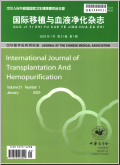肾移植术后下肢深静脉血栓形成三例并文献分析
Deep venous thrombosis in the lower extremities in three patients after kidney transplantation and literature review
摘要目的 探讨肾移植术后下肢深静脉血栓(deep venous thrombosis in the lower extremities,LDVT)形成的危险因素、常用诊断方法及其治疗方案.方法 回顾性分析郑州大学第一附属医院肾移植科2014年12月至今3例肾移植术后LDVT受者的临床诊治资料.结果 肾移植受者围手术期存在较多LDVT形成的危险因素.彩色多普勒超声检查和血浆D-二聚体(D-dimer)检测可作为常规诊断方法,常用的尿激酶+低分子肝素+华法林的治疗方案有较好的可行性及安全性,活化部分凝血活酶时间、国际化标准比率等可作为溶栓抗凝药物用量的调整指标.结论 应对肾移植受者进行严格的术前检查,尽可能避免LDVT形成的危险因素;对于疑似LDVT患者,使用彩色超声多普勒检查明确诊断并予以及时干预;尿激酶+低分子肝素+华法林用药方案可取得良好临床效果,但应注意监测活化部分凝血活酶时间、国际化标准比率等指标变化.
更多相关知识
abstractsObjective To investigate the risk factors,the commonly used diagnostic method and the therapeutic regimens of the deep venous thrombosis in the lower extremity (LDVT) in patients after kidney transplantation.Methods The clinical data of three LDVT patients after kidney transplantation was analyzed.Results Many risk fators of LDVT existed during the perioperative period of kidney transplantation,which should be monitored and prevented.The combination of color ultrasonic doppler examination and the concentration of D-dimer in the plasma was the routine diagnostic method.The combined treatment of urokinase and low molecular heparin and warfarin could achieve good feasibility and safety.Activated partial thromboplastin time(APTT) and international standard ratio(INR) could be used as the adjustment index of thrombolytic and anticoagulant dosage.Conslusions Strict preoperative examination of renal transplant recipients is essential to help us to find out the risk factors and prevent them as far as possible.The suspected patients could have definite diagnosis with the color ultrasonic doppler examination.The immediate therapy should be applied once LDVT is diagnosed.The treatment of urokinase,low molecular heparin and warfarin can achieve benign clinical results.In addition,we should carefully monitor the change of APTT and INR.
More相关知识
- 浏览203
- 被引3
- 下载171


相似文献
- 中文期刊
- 外文期刊
- 学位论文
- 会议论文



 换一批
换一批 换一批
换一批



